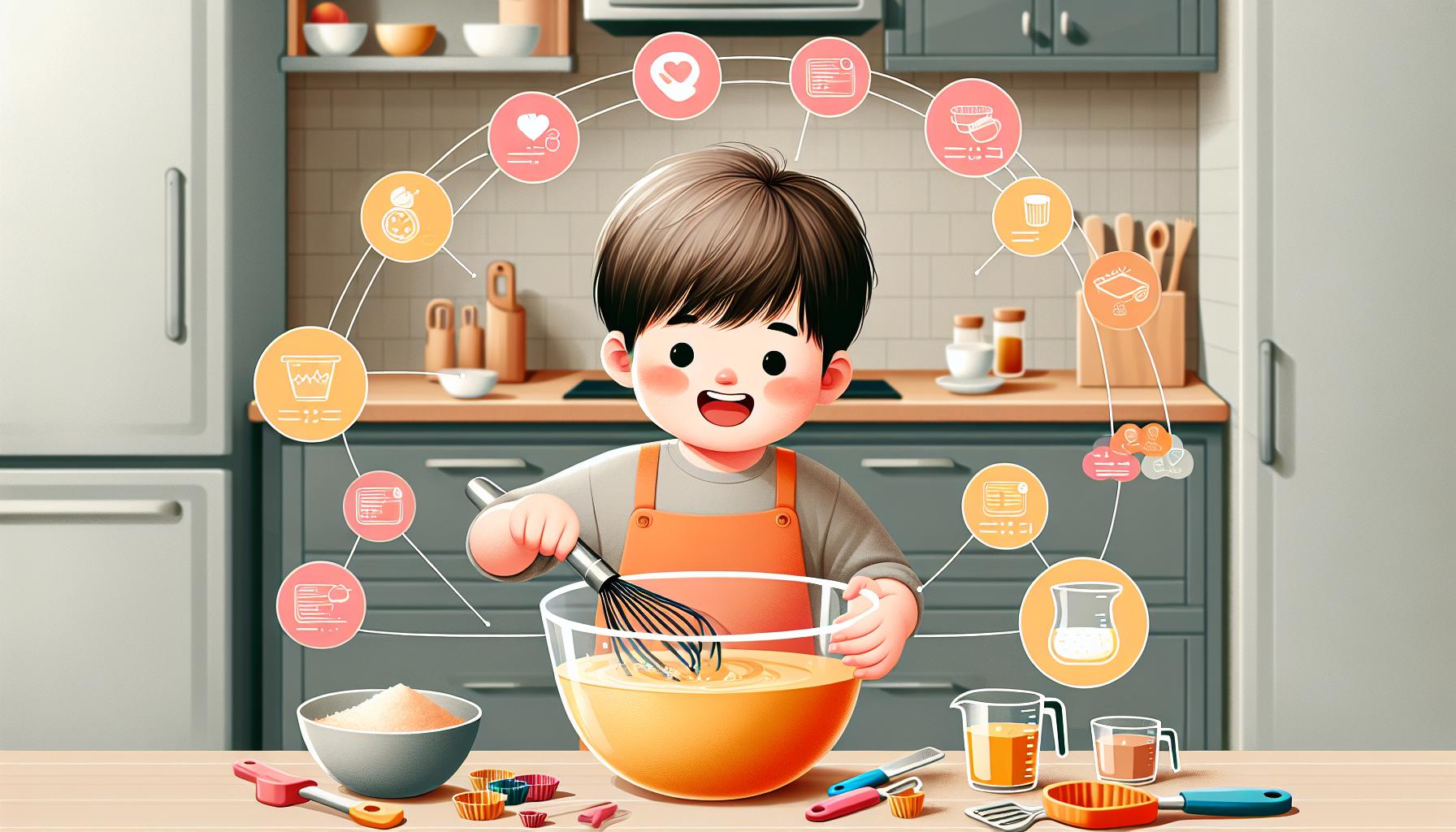
Baking with kids creates precious family memories while teaching valuable life skills. We’ve found that introducing children to the art of baking early helps them develop confidence in the kitchen and sparks their creativity. From measuring ingredients to following recipes together, these moments become cherished learning experiences for both parents and little ones.
Starting your baking journey doesn’t have to feel overwhelming. With pre-measured ingredients and clear instructions, even beginners can create delicious homemade treats without stress. Have you ever watched your child’s face light up when pulling freshly baked cookies from the oven? That’s the magic of baking – it transforms simple ingredients into moments of pure joy while teaching patience, precision, and creativity along the way.
Key Takeaways
- Baking with kids provides valuable learning opportunities, teaching essential skills like math, following instructions, and kitchen safety while creating lasting family memories
- Start with age-appropriate tasks – younger children (2-3) can help with simple mixing and decorating, while older kids (9+) can handle more complex techniques like using mixers and basic knife skills
- Essential kid-friendly equipment includes plastic mixing bowls with non-slip bases, silicone spatulas, child-sized measuring tools, and appropriately sized oven mitts for safety
- Begin with simple recipes like no-bake cookies or basic sugar cookies that use few ingredients and build fundamental baking techniques without overwhelming new bakers
- Keep the kitchen organized by pre-measuring ingredients, setting up designated workstations, and implementing smart cleanup strategies to make the experience more enjoyable
- Focus on kitchen safety by teaching proper hand washing, identifying hot surfaces, using tools correctly, and maintaining adult supervision throughout the baking process
Why Baking With Kids Is Important
Baking with kids creates meaningful family moments while teaching essential skills through hands-on activities. The kitchen transforms into a learning lab where children develop confidence through measuring, mixing, and creating delicious treats.
Life Skills They’ll Learn
Kids gain valuable skills through baking activities:
- Math Skills: Children practice addition, fractions, and measurements while portioning ingredients
- Following Instructions: Reading recipes builds sequential thinking and attention to detail
- Fine Motor Skills: Stirring, kneading, and decorating enhance hand-eye coordination
- Time Management: Learning to prep ingredients and monitor baking times develops planning abilities
- Creativity: Decorating baked goods allows artistic expression and imagination
- Problem Solving: Troubleshooting recipe issues builds critical thinking abilities
- Teamwork: Working together in the kitchen develops collaboration skills
- Kitchen Science: Understanding ingredient reactions introduces basic chemistry concepts
- Hand Washing: Practice proper cleaning techniques before handling food
- Hot Surfaces: Learn to identify dangerous areas like ovens and stovetops
- Sharp Objects: Demonstrate safe handling of kitchen tools based on age
- Clean Workspace: Maintain organized counters to prevent accidents
- Food Safety: Store ingredients properly and check expiration dates
- Emergency Response: Know basic first aid and emergency procedures
- Proper Attire: Wear aprons, closed-toe shoes, and tie back long hair
- Adult Supervision: Set clear boundaries for tasks requiring oversight
| Age Group | Recommended Safety Tasks |
|---|---|
| 2-3 years | Washing fruits, stirring dry ingredients |
| 4-5 years | Measuring, pouring, mixing |
| 6-8 years | Rolling dough, decorating |
| 9+ years | Using hand mixers, basic knife skills |
Essential Baking Equipment for Kids

Introducing kids to baking starts with the right tools that fit small hands. A well-equipped kitchen creates a safe environment for young bakers to explore their culinary creativity.
Child-Friendly Kitchen Tools
Kid-friendly baking tools enhance safety while making the experience enjoyable. Here’s what to include:
- Plastic mixing bowls with non-slip bases
- Silicone spatulas in bright colors
- Wooden spoons sized for small hands
- Measuring cups with large handles
- Clear measuring spoons with bold numbers
- Non-slip mixing mats
- Plastic cookie cutters
- Child-sized aprons with adjustable straps
- Oven mitts designed for kids
- Plastic rolling pins
- All-purpose flour in airtight containers
- Granulated sugar in easy-pour containers
- Baking powder with clear expiration dates
- Baking soda in resealable packages
- Pure vanilla extract
- Salt in shaker containers
- Unsalted butter
- Large eggs
- Milk
- Vegetable oil
| Item Type | Recommended Quantity | Storage Duration |
|---|---|---|
| Flour | 5 pounds | 6-8 months |
| Sugar | 4 pounds | 12 months |
| Butter | 2 pounds | 3 months frozen |
| Eggs | 1 dozen | 4-5 weeks |
| Milk | 1 gallon | 1 week |
Easy Starter Recipes for Kids

Starting with simple recipes builds confidence in young bakers while teaching fundamental baking skills. Here’s a selection of beginner-friendly recipes perfect for kids ages 4-12.
No-Bake Cookie Treats
No-bake cookies introduce kids to basic kitchen skills without the risks of hot ovens. These treats require just 5 ingredients: graham crackers, butter, powdered sugar, vanilla extract, and chocolate chips. Kids practice measuring liquids and dry ingredients while developing motor skills through mixing and shaping.
Steps for Success:
- Crush graham crackers in a sealed bag
- Mix ingredients in a large bowl
- Shape mixture into small balls
- Roll in powdered sugar
- Chill for 30 minutes
Simple Sugar Cookies
Sugar cookies offer an ideal introduction to traditional baking with basic ingredients. The dough is forgiving and perfect for practicing rolling, cutting shapes and decorating.
Key Features:
- Uses 6 basic ingredients
- Takes 45 minutes total
- Makes 24 cookies
- Requires minimal tools
| Ingredient | Amount | Notes |
|---|---|---|
| Flour | 2 cups | All-purpose |
| Sugar | 1 cup | Granulated |
| Butter | 1 stick | Room temperature |
| Eggs | 1 large | Room temperature |
| Vanilla | 1 tsp | Pure extract |
| Salt | 1/4 tsp | Table salt |
Tips for Success:
- Let kids measure dry ingredients
- Show proper mixing techniques
- Demonstrate rolling techniques
- Guide cookie cutter placement
- Supervise oven operations
Each recipe builds essential skills through hands-on practice with pre-measured ingredients and clear instructions. The focus remains on creating enjoyable experiences while teaching fundamental baking concepts.
Making the Experience Fun and Educational
Baking with kids creates an engaging blend of entertainment and learning opportunities. The kitchen transforms into an interactive classroom where children discover new skills through hands-on activities.
Age-Appropriate Tasks
Kids of different ages excel at specific baking tasks that match their developmental stages:
Ages 2-3:
- Pouring pre-measured ingredients into bowls
- Stirring dry ingredients with a wooden spoon
- Decorating cookies with sprinkles
- Pressing cookie cutters into soft dough
Ages 4-6:
- Measuring dry ingredients
- Cracking eggs into a separate bowl
- Rolling dough with supervision
- Greasing baking pans
- Using cookie cutters independently
Ages 7-9:
- Reading simple recipes
- Measuring wet ingredients
- Mixing batters with an electric mixer
- Kneading dough
- Basic decoration techniques
Ages 10+:
- Reading complex recipes
- Operating timers
- Using the oven with supervision
- Advanced decoration methods
- Converting measurements
Teaching Kitchen Science
The kitchen offers countless opportunities to explore scientific concepts:
Physical Changes:
- Observing butter melting
- Watching dough rise
- Seeing batter transform into cake
- Noting color changes during baking
Chemical Reactions:
- Mixing baking soda with acidic ingredients
- Combining wet and dry ingredients
- Understanding yeast activation
- Learning about emulsification
- Converting cups to tablespoons
- Understanding fractions through measuring
- Learning volume relationships
- Practicing precision in measurements
- Testing heat’s impact on ingredients
- Learning about freezing points
- Understanding melting processes
- Exploring how temperature affects baking time
Tips for Minimizing Kitchen Mess
Keeping the kitchen tidy while baking with kids creates a more enjoyable experience for everyone. These practical strategies help maintain order during your baking adventures.
Smart Prep Strategies
- Cover the workspace with parchment paper or silicone mats to catch spills
- Pre-measure ingredients into small bowls before involving kids
- Set up designated stations for wet ingredients, dry ingredients and tools
- Keep paper towels or clean kitchen towels within easy reach
- Store frequently used items like measuring cups at kid-height
- Place a rimmed baking sheet under mixing bowls to contain spills
- Use clear containers labeled with pictures for young bakers
- Keep a step stool nearby so kids can reach the sink for hand washing
- Sweep flour spills with a pastry brush instead of wiping with wet cloths
- Place dirty measuring cups in a bowl of warm water while baking
- Line garbage bins with double bags for easy cleanup
- Use washable placemats under each child’s work area
- Keep cleaning supplies organized in a nearby caddy
- Assign specific clean-up tasks to each child based on age
- Clean bowls and tools between recipe steps to prevent buildup
- Use disposable piping bags for decorating to reduce mess
| Clean-Up Item | Location | Purpose |
|---|---|---|
| Paper Towels | Counter | Quick spill cleanup |
| Cleaning Caddy | Under Sink | Organized supplies |
| Garbage Bowl | Work Station | Immediate waste disposal |
| Step Stool | By Sink | Kid-height access |
Conclusion
Baking with kids is more than just creating delicious treats – it’s about building lasting memories and essential life skills. We’ve seen how the kitchen can transform into a magical classroom where young minds flourish through hands-on learning.
Whether you’re starting with simple no-bake cookies or advancing to decorated sugar cookies the journey of baking together will create priceless family moments. By following age-appropriate tasks and safety guidelines we can make every baking session both fun and educational.
Ready to start your baking adventure? Remember that perfectly measured ingredients and spotless results aren’t the goal. What matters most is the joy confidence and skills our little ones gain along the way. So put on those aprons gather your ingredients and let’s start making sweet memories together!
Frequently Asked Questions
At what age can children start baking?
Children can start participating in baking activities as early as age 2-3 with simple tasks like pouring pre-measured ingredients and stirring. As they grow, they can take on more complex tasks. By age 10, most children can handle basic baking activities with supervision.
What are the essential tools needed for baking with kids?
Basic tools include plastic mixing bowls, silicone spatulas, measuring cups and spoons, child-sized aprons, and non-slip mixing bowls. Avoid sharp or heavy equipment. Child-friendly tools with bright colors and proper sizing make baking safer and more engaging.
How does baking benefit children’s development?
Baking enhances math skills through measuring, develops fine motor skills via mixing and pouring, teaches patience and following instructions, and boosts creativity. It also promotes problem-solving abilities, teamwork, and basic understanding of kitchen science.
What are some easy recipes for beginner child bakers?
No-bake cookies and simple sugar cookies are perfect starter recipes. No-bake cookies require minimal ingredients and no oven use, while sugar cookies introduce basic baking techniques and decorating fun. Both recipes help build confidence and fundamental skills.
How can I keep the kitchen clean while baking with kids?
Cover workspaces with parchment paper, pre-measure ingredients, and create designated stations for wet and dry ingredients. Assign age-appropriate clean-up tasks and keep cleaning supplies readily available. Good organization helps maintain a manageable baking environment.
What safety precautions should be taken when baking with children?
Always supervise children, enforce proper hand washing, teach hot surface awareness, and demonstrate safe handling of kitchen tools. Use age-appropriate tasks and equipment. Keep a first-aid kit nearby and ensure children understand basic kitchen safety rules.
How can baking be used as an educational tool?
Baking naturally teaches math through measurements, science through chemical reactions and physical changes, and reading comprehension through recipes. It also provides hands-on learning about temperature, time management, and cause-and-effect relationships.
What are signs that a child is ready for more complex baking tasks?
Look for demonstrated responsibility with current tasks, understanding of basic kitchen safety, ability to follow multi-step instructions, and genuine interest in learning more. Physical capabilities and maturity level should also be considered.

